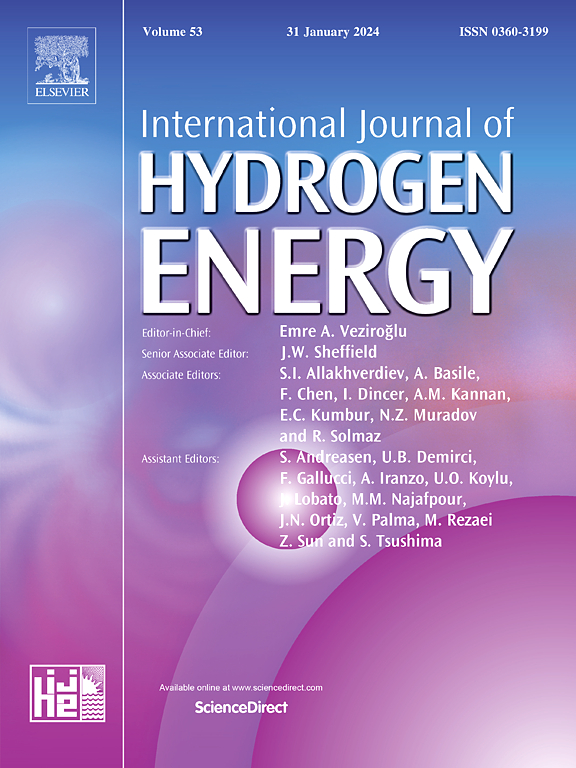Optimizing dual fuel engine performance with hydrogen-enriched syngas from co-pyrolysis of biodegradable and non-biodegradable wastes
IF 8.3
2区 工程技术
Q1 CHEMISTRY, PHYSICAL
引用次数: 0
Abstract
This study explores the production of hydrogen-enriched syngas from waste groundnut shells and waste milk covers through a catalyst bed-based co-pyrolysis process. The objective was to develop an efficient method for producing high-quality syngas, enhancing its hydrogen content, and evaluating its performance as a fuel in a compression ignition (CI) engine. The experimental setup involved co-pyrolysis at temperatures between 550 °C and 600 °C using Ni/Al2O3 and La/Al2O3 as catalysts. Gas chromatography analysis revealed that Ni/Al2O3 catalyst produced syngas with a hydrogen concentration of 38.28 % and a total yield of 68 %, while La/Al2O3 resulted in 35.45 % hydrogen with a 65.2 % yield. The CI engine tests demonstrated improved brake thermal efficiency (BTE) in dual fuel mode, reaching 32.20 % with hydrogen-enriched syngas, compared to 30.98 % with syngas without hydrogen enrichment. Specific fuel consumption (SFC) was reduced to 0.28051 kg/kW-hr. Emission analysis showed significant reductions in hydrocarbons (HC) and carbon monoxide (CO) emissions, though nitrogen oxide (NOx) emissions increased. The study concludes that hydrogen-enriched syngas, produced from waste materials, is a viable alternative fuel, offering enhanced engine performance and lower environmental impact, despite the challenge of increased NOx emissions.
利用可生物降解和不可生物降解废物共热解的富氢合成气优化双燃料发动机性能
本研究探索了利用废花生壳和废牛奶盖在催化床上共热解生产富氢合成气的工艺。目标是开发一种高效的方法来生产高质量的合成气,提高其氢含量,并评估其作为压缩点火(CI)发动机燃料的性能。实验装置采用Ni/Al2O3和La/Al2O3作为催化剂,在550 ~ 600℃的温度下共热解。气相色谱分析表明,Ni/Al2O3催化剂生成的合成气氢气浓度为38.28%,总收率为68%;La/Al2O3催化剂生成的合成气氢气浓度为35.45%,总收率为65.2%。CI发动机测试表明,在双燃料模式下,富氢合成气的制动热效率(BTE)达到32.20%,而不富氢合成气的制动热效率为30.98%。比油耗(SFC)降至0.28051 kg/kW-hr。排放分析显示,碳氢化合物(HC)和一氧化碳(CO)排放量显著减少,但氮氧化物(NOx)排放量增加。该研究得出结论,尽管氮氧化物排放增加,但从废物中生产的富氢合成气是一种可行的替代燃料,可以提高发动机性能并降低对环境的影响。
本文章由计算机程序翻译,如有差异,请以英文原文为准。
求助全文
约1分钟内获得全文
求助全文
来源期刊

International Journal of Hydrogen Energy
工程技术-环境科学
CiteScore
13.50
自引率
25.00%
发文量
3502
审稿时长
60 days
期刊介绍:
The objective of the International Journal of Hydrogen Energy is to facilitate the exchange of new ideas, technological advancements, and research findings in the field of Hydrogen Energy among scientists and engineers worldwide. This journal showcases original research, both analytical and experimental, covering various aspects of Hydrogen Energy. These include production, storage, transmission, utilization, enabling technologies, environmental impact, economic considerations, and global perspectives on hydrogen and its carriers such as NH3, CH4, alcohols, etc.
The utilization aspect encompasses various methods such as thermochemical (combustion), photochemical, electrochemical (fuel cells), and nuclear conversion of hydrogen, hydrogen isotopes, and hydrogen carriers into thermal, mechanical, and electrical energies. The applications of these energies can be found in transportation (including aerospace), industrial, commercial, and residential sectors.
 求助内容:
求助内容: 应助结果提醒方式:
应助结果提醒方式:


